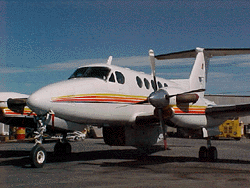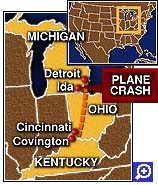- Crash Investigations and Archive
- This page is used to organize information about particular crash types.
This is the subject of my work.
-
- [ Flight Recorders ]
Focus
- The Crash below is the focus of another development I am working
on with the help of a private scientist.
- "The prevention of post crash fires." More to come soon.
25-May-2001 12:35 PM U.S. EDT
 Patricia Hilliard Robertson, 38. A NASA astronaut who was severely burned in a small plane
crash outside of Houston died from her injuries, the U.S. space agency say. see full story
Patricia Hilliard Robertson, 38. A NASA astronaut who was severely burned in a small plane
crash outside of Houston died from her injuries, the U.S. space agency say. see full story
F light 4184 was stuck in a holding pattern late on Halloween
afternoon, waiting to land at Chicago's O'Hare airport. The weather was lousy: drizzle at
10,000 feet, the temperature near freezing. In the cockpit of the ATR-72 twin turboprop,
the pilots flipped on the wing de-icers, letting the autopilot guide the aircraft through
a series of lazy turns. The plane had been circling for 30 minutes. Things were getting a
little boring.
Then it happened.
Links

|
Airline
Safety - Hijacking
'Take This Plane To Cuba' - Hijacking is the nightmare of every airline captain, and more
than a minor inconvenience for passengers caught up in some piece of political nonsense;
indeed, many innocent victims have lost their lives in hijacking incidents. September 11 Crashes
Aircrash
- Burnelli Aircraft
European mirror site.
AirDisaster.com
Airline accident site, but not too sensational. Database, CVR tracks, photos - plus links
to accounts of individual accidents.
Airsafe
Comprehensive listing of fatal airline accidents since 1970, by airline and model.
ATR
42 and 72 - Flight in Icing Conditions
US News story from 1995 about the American Eagle Flight 4184 accident caused by loss of
control in icing conditions. Read a previous article on the same subject here.
Aviation
Accident Database
Accident databases for 1908 to the present, plus Accidents by Operator; Accidents by Type;
Twenty Worst Aviation Disasters and other articles.
Aviation
/ AeroMed Articles and Publications.
Links to a host of fascinating HPF and aeromedical reports and documents, from 'Alcohol
and Aviation' to 'Approach and Landing Illusions'.
Aviation
Safety
Site dedicated to exposing alleged cover-ups, corruption and collusion between the FAA and
industry. Is it profits over people, or just paranoia? You decide.
Aviation
Safety Data Exchange
A source of important safety information for GA, homebuilt and ultralight aircraft.
Includes Advisory Circulars, Airworthiness Directives, Accident Reports and more.
Aviation
Safety Network
The Aviation Safety Network covers accidents and safety issues concerning airliners.
Includes accident database, safety issues, accident reports, CVR transcripts and much
more. |
News
6-10-2001 TWO FAMOUS PILOTS DIE IN YAK CRASH
Two pilots who became famous for surviving tremendous odds died Sunday after the Yak
52 they were flying crashed near Custer, Washington. The cause of the crash remains
unclear. Alexander M. Zuyev, 39, and Jerry Michael Warren, 50, were killed when they were
trying to rejoin a group of other airplanes. At least two of the other airplanes were also
Yaks, NTSB investigator Dennis Hogenson told ePilot. A witness told Hogenson that
the Yak banked to the left at 1,200 feet, stalled, and crashed. Hogenson said he has
doubts about a stall scenario based on the combined experience of the pilots. He is
continuing to interview witnesses and is awaiting a coroner's report. Zuyev, a former
Soviet air force officer, became known internationally when he fled from his country in a
MiG-29 in 1989. He was chased by Soviet fighters and wounded by gunfire before landing
safely in Turkey. Warren and his son became famous after they were pulled from a Cessna
150 that was entangled upside down, 60 feet above the ground, in high-voltage wires near
King County International Airport in 1998.
Contact with OSU aircraft was lost before it went down, investigator
says
January 28, 2001
Web posted at: 2120 GMT Memorial
of Victims
 |
|
Pilot 
Denver Mills, 55, of Oklahoma
City, was an experienced pilot and had flown Oklahoma State sports teams for several
years. He leaves a wife, Lindell Mills; son, David Mills, 21, a student at OSU; and
daughters Kathryn Wilson and Debra Mills. |

Bjorn Fahlstrom, 30, co-pilot. He
was born in Kalmar, Sweden, and had been pro tennis player. He came to Oklahoma City in
1996 to learn to fly. He had been flying corporate jets for about 1 1/2 years. His
fiancee, Jacqueline Oda, lives in Oklahoma City.
|
Date: 01/09/1997
Location: Ida, Michigan
Airline: Comair (Delta Connection)
Aircraft: Embraer EMB-120RT Brasilia
Registration: N265CA
Fatalities/No. Aboard: 29:29
Details: While on approach and attempting to land on runway 3R at Detroit Metropolitan
Wayne County Airport, in a snowstorm, the aircraft went into a steep dive and crashed into
a field. The accident was caused by the FAA's failure to establish adequate aircraft
certification standards for flight in icing conditions. Contributing to the accident were
the flightcrew's decision to operate in icing conditions near the lower margin of the
operating airspeed envelope (with flaps retracted), and Comair's failure to establish and
adequately disseminate unambiguous minimum airspeed values for flap configurations and for
flight in icing conditions.
Icing possible cause of Michigan plane crash
January 10, 1997
Web posted at: 10:25 p.m. EST
Latest developments:
RAISINVILLE
TOWNSHIP, Michigan (CNN) -- Flights in and out of Detroit's airport were icing up
before a commuter plane, trying to land in a snowstorm, went into a roll and nose- dived
into a field, killing all 29 people aboard.
Also, records of the plane involved in the crash indicate that on at least two
occasions, the plane's de-icing system failed and had to be repaired.

While the weather is an obvious possibility as to what caused the crash of Comair
Flight 3272, National Transportation Safety Board member John Hammerschmidt said Friday it
was too soon to speculate about the cause.
The plane, an Embraer 120 twin-engine turboprop operated by Comair, went down at dusk
Thursday, 18 miles short of Detroit Metropolitan Airport without any mention of trouble
from the pilot.
By late Friday, the NTSB had found the two black box flight recorders that might yield
clues to the cause of the accident. Crews were still working to recover bodies from the
burned and splintered wreckage.

According to Detroit Metropolitan Airport spokesman Mike Conway, planes at the Detroit
airport had to be de-iced frequently in Thursday's snow and cold.
"We had precipitation all day, and the airlines were de-icing aircraft all
day," he said.
Ice disrupts airflow over the wings and can cause planes to stall or roll. One witness
to the Comair crash, Ted Rath, said he saw the plane roll three times before it crashed
into a snowy field.

At a press conference Friday night, Hammerschmidt said conditions at the time of the
crash were light snow, mist, light winds and moderate turbulence. The forecast also called
for "light to moderate icing," and he noted that the pilot of a small plane had
reported severe icing near Finlay, Ohio.
But Hammerschmidt noted that the Brazilian-made Embraer 120 was equipped with systems
to de-ice the wings, propellers and engines during flight.
Those de-icing systems include inflatable, leading-edge icing boots on the wings,
heated, leading edges on the propellers and heated inlet probes in the engines, he said.
However, Federal Aviation Administration records indicate that the Embraer 120 involved
in the crash experienced two failures of de-icing systems in the past.
The system that prevents icing on the wing's airfoil failed during a flight on March
19, 1994. A part, described as worn, was replaced and the problem was considered fixed,
according to records obtained by CNN.
On February 11, 1993, the system that prevents icing on the engine intake inlets failed
during a flight. A valve deemed to be defective was then replaced.
Last year, the Federal Aviation Administration issued an "Airworthiness
Directive" concerning problems found with icing of wings and propellers on the
Embraer 120.
The directive ordered aircraft owners to post a notice in their flight manuals which
warned: "Flight in freezing rain, freezing drizzle, or mixed icing conditions may
result in ice build-up on protected surfaces exceeding the capability of the ice
protection system, or may result in ice forming aft of the protected surfaces. This ice
may not be shed using the ice protection systems, and may seriously degrade the
performance and controllability of the airplane."
The directive warned pilots to keep a close eye for clues to icing on the wings and
propeller blades and ordered them not to use the autopilot system under those
circumstances.
In 1994, an American Eagle ATR-72 that had been in a holding pattern in icy weather for
nearly 40 minutes suddenly rolled and crashed near Roselawn, Indiana, killing 68 people.
Investigators blamed ice on the wings.
The Comair flight, however, had not been in a holding pattern, and the NTSB's
Hammerschmidt noted the plane was equipped with three de-icing systems.
At the crash scene, sheriff's deputies carried victims' remains to a hangar nearby. The
wreckage and the bodies were scattered over a 100-by 200-yard area in weeds and snow, and
in a 4-foot-deep crater gouged out by the plane.
The investigation was slowed by snow and below-zero wind- chill readings that prevented
investigators from working outside for more than 15 or 20 minutes at a time, Hammerschmidt
said.
According to FAA records, maintenance on the plane's propeller and de-icing equipment
was performed in 1993 and 1994. The plane's last major maintenance check was on November
20, the airline said.
In fatal crashes of Embraer 120s in 1991 and 1995, propellers were cited as the cause.
In the latter, near Carrollton, Georgia., a section of a prop blade on the left engine
broke off and fell to the ground miles from the crash.
The NTSB later concluded that an undetected crack in the blade caused the failure which
led to the crash.
A spokesman with Hamilton Standard, which manufactures the propellers used on Embraer
120s, said blades on all Comair planes were repaired by last August.
Among those killed in the Comair crash were a woman who was on the way to the funeral
of her brother, who was himself killed in a cargo jet crash in Virginia; a Procter &
Gamble executive recruiting at the University of Michigan; and a university student
heading home from an interview with Procter & Gamble.
- 11 September 2001; American Airlines 767 (Flight 11);
World Trade Center, New York: The aircraft was on a flight from Boston to Los
Angeles when it was apparently hijacked and flown into one of the World Trade Center
Towers. Another jet, a United Airlines 767, was apparently hijacked and crashed into the
other tower. Both towers later collapsed. All 11 crew members, 76 passengers, and five
hijackers were killed, as were untold numbers of people on the ground.
Fatal American Airlines Events
Fatal 767 Events
Attack on New York and Washington
- 11 September 2001; United Airlines 767 (Flight 175); World Trade Center, New
York: The aircraft was on a flight from Boston to Los Angeles when it was
apparently hijacked and flown into one of the World Trade Center Towers. Another jet, an
American Airlines 767, was apparently hijacked and crashed into the other tower. Both
towers later collapsed. All nine crew members, 51 passengers, and five hijackers were
killed, as were untold numbers of people on the ground.
Fatal United Airlines Events
Fatal 767 Events
Attack on New York and Washington
- 11 September 2001; American Airlines 757 (Flight 77); The Pentagon, Arlington,
VA: The aircraft was on a flight from Dulles to Los Angeles when it was
apparently hijacked and flown into the Pentagon, collapsing part of the structure. All six
crewmembers, 53 passengers, and five hijackers were killed.
Fatal American Airlines Events
Fatal 757 Events
Attack on New York and Washington
- 11 September 2001; United Airlines 757 (Flight 93); near Pittsburgh, PA:
The aircraft was on a flight from Newark to San Francisco when it was apparently hijacked.
However, the aircraft crashed outside Pittsburgh. All seven crewmembers, 34 passengers,
and four hijackers were killed.
Fatal American Airlines Events
Fatal 757 Events
Attack on New York and Washington

 Patricia Hilliard Robertson, 38. A NASA astronaut who was severely burned in a small plane
crash outside of Houston died from her injuries, the U.S. space agency say. see full story
Patricia Hilliard Robertson, 38. A NASA astronaut who was severely burned in a small plane
crash outside of Houston died from her injuries, the U.S. space agency say. see full story





